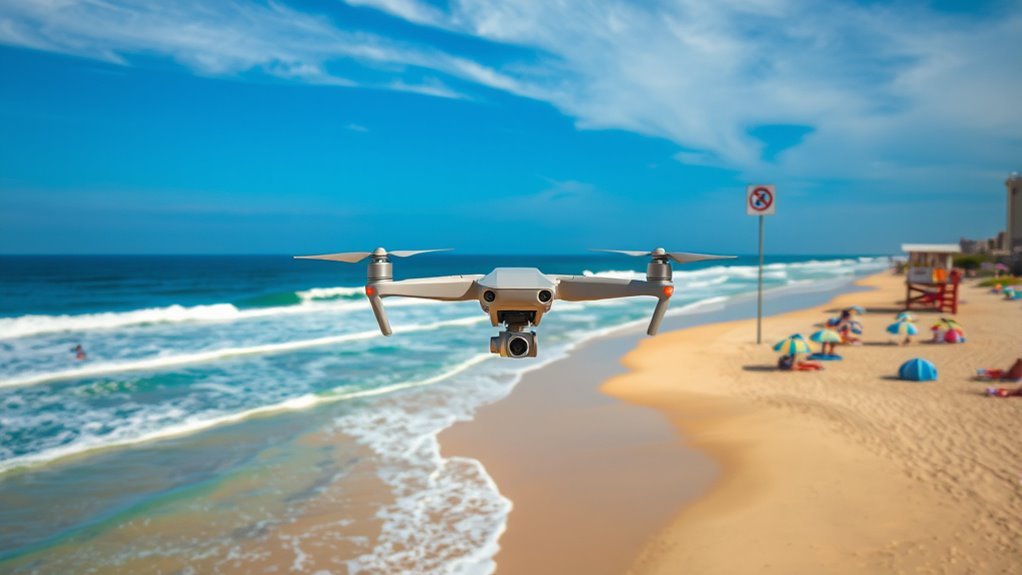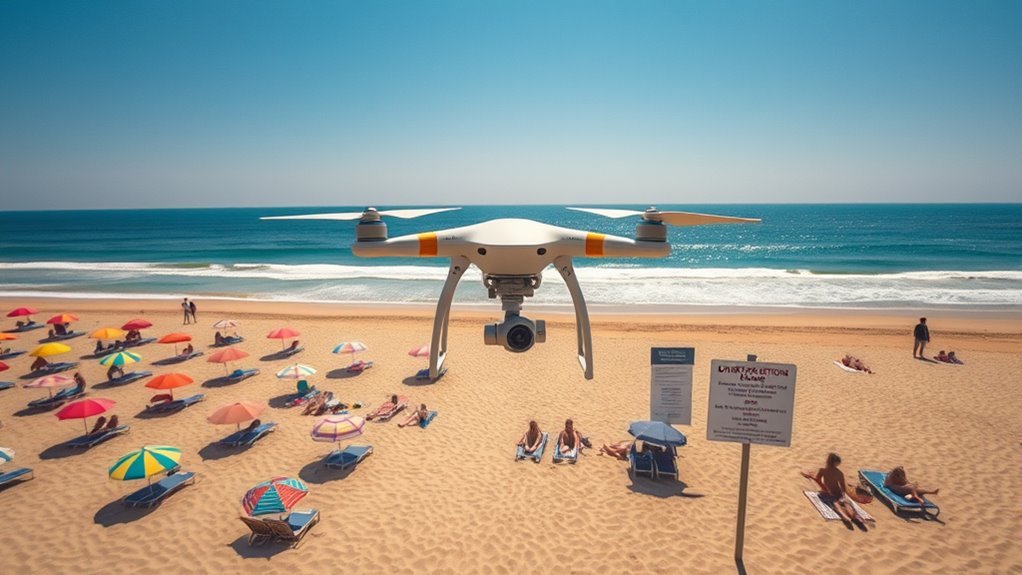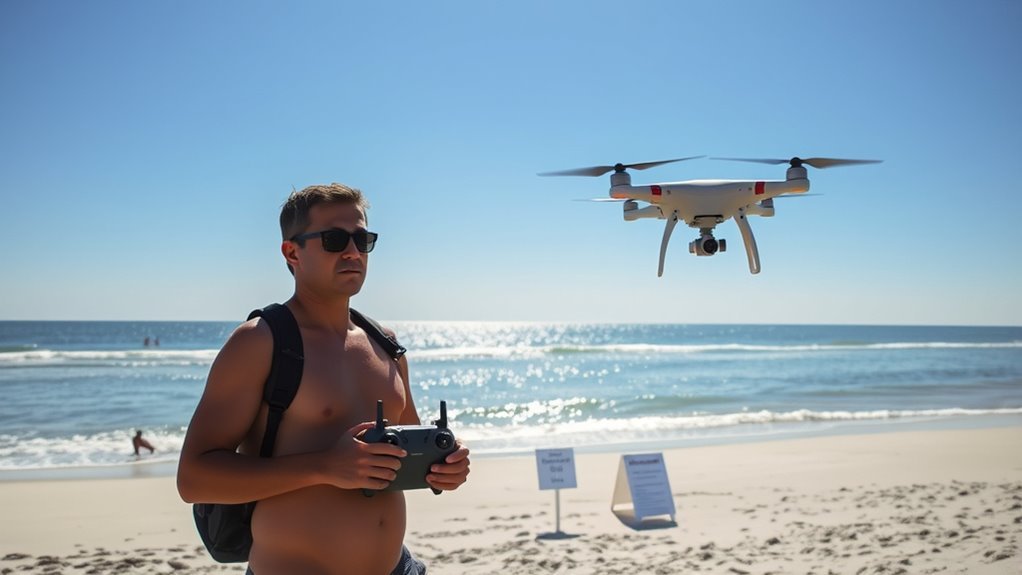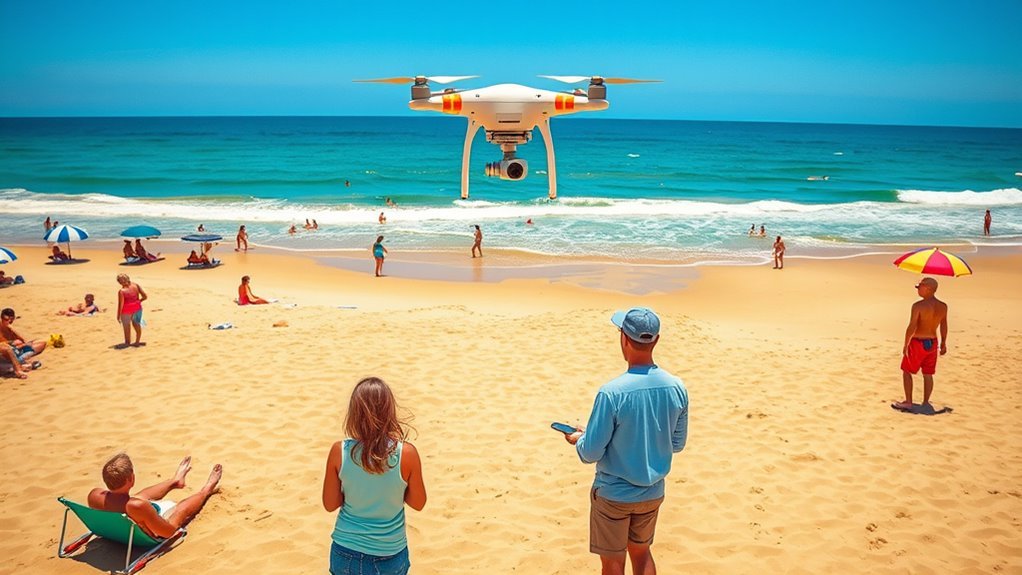To fly drones on the beach, you must follow local regulations and FAA guidelines. Always register your drone and keep a safe distance of at least 150 feet from crowds and 200 feet from wildlife. Respect privacy laws by avoiding private properties and capturing images without consent. Keep an eye on weather conditions and battery life to avoid issues. By observing these rules, you’ll guarantee an enjoyable experience while staying compliant, and there’s more to explore about safe practices.
Understanding Local Drone Regulations

When you’re planning to fly a drone on the beach, it’s crucial to understand the local regulations that govern this activity. Each beach may have unique rules, including specific local drone permits you might need. Before launching your drone, check for any beach drone restrictions that could limit your flying height, times, or designated zones. Some areas may prohibit drones altogether to protect wildlife, minimize disturbances, or guarantee public safety. Familiarizing yourself with these regulations not only keeps you compliant but also enhances your flying experience. Ignoring local laws can lead to fines or confiscation of your equipment, so take the time to research and respect the rules. Your freedom to fly depends on your willingness to follow these guidelines.
Federal Aviation Administration (FAA) Guidelines

Understanding local regulations is just one part of responsible drone flying; you also need to be aware of the Federal Aviation Administration (FAA) guidelines that apply to all drone operators in the United States. First and foremost, make certain to register your drone if it weighs over 0.55 pounds. This registration process guarantees accountability and safety in the skies. Additionally, keep detailed flight logs to track your drone’s operation and maintenance. This not only helps in adhering to regulations but can also assist if issues arise. Remember, flying responsibly means respecting airspace restrictions and avoiding populated areas. By following these FAA guidelines, you’ll not only enjoy your freedom to fly but also help foster a safe environment for everyone.
Respecting Privacy Laws

Although flying a drone can be an exhilarating experience, it’s essential to respect privacy laws to guarantee that your enjoyment doesn’t infringe on the rights of others. When you’re at the beach, keep in mind that many people are there to relax, not to be subject to drone surveillance. Avoid hovering over private properties or capturing images of individuals without their consent, as this can lead to serious privacy concerns. Always be aware of your surroundings and the potential implications of your actions. If someone expresses discomfort, be courteous and adjust your flight path. By respecting privacy laws, you’ll not only enjoy your drone experience but also foster a positive environment for everyone at the beach.
No-Fly Zones and Restricted Areas
Whether you’re an experienced drone pilot or a beginner, it’s vital to familiarize yourself with no-fly zones and restricted areas before taking off at the beach. Many beaches have specific drone access regulations, often prohibiting flights over crowds, protected wildlife habitats, or sensitive areas. You’ll want to check local regulations and any temporary flight restrictions that may apply. Additionally, understanding drone registration requirements is important—flying an unregistered drone can lead to fines or confiscation. Always consult your local authority or the FAA’s website for up-to-date information. By respecting these zones and regulations, you not only guarantee your freedom to fly but also promote safety and enjoyment for everyone at the beach.
Maintaining Safe Distances From People and Wildlife
To guarantee a safe and enjoyable experience for both drone pilots and beachgoers, it’s critical to maintain appropriate distances from people and wildlife while flying. Always keep a minimum of 150 feet away from crowds to guarantee effective crowd management, allowing everyone to enjoy their beach time without distraction or danger. When it comes to wildlife observation, be especially cautious; many species are sensitive to disturbances. Maintain at least 200 feet from wildlife, particularly nesting birds or marine animals, to avoid disrupting their natural behavior. Respecting these distances not only protects the environment but also enhances your freedom to fly your drone responsibly. By being mindful of your surroundings, you contribute to a harmonious beach experience for all.
Weather Considerations for Beach Drone Flights
When planning to fly your drone on the beach, it is essential to take into account the weather conditions, as they can greatly impact your flight experience and safety. Wind conditions are particularly important; strong winds can make maneuvering your drone challenging and may even cause it to drift unpredictably. It’s advisable to check local forecasts and avoid flying in gusty weather. Additionally, be mindful of tidal effects, especially if you’re near the water. Rising tides can create unpredictable situations, potentially leading to your drone being swept away. Always guarantee you have a clear understanding of the weather before taking off, as this knowledge not only enhances your freedom to fly but also guarantees a safe and enjoyable experience.
Battery Life and Flight Time Management
When flying your drone at the beach, it’s essential to monitor battery levels closely to avoid unexpected landings in the sand. Planning your flight duration based on your battery life guarantees you capture the best shots without risking a crash. Always keep a close eye on these factors to enhance both safety and performance. Additionally, understanding battery capacity can help you make informed decisions about how long you can fly before needing to recharge.
Monitor Battery Levels
As you prepare to fly your drone on the beach, keeping a close eye on battery levels is essential for ensuring a safe and enjoyable experience. To maximize your drone’s battery lifespan, regularly check the power management settings. Monitor the voltage indicators, and be aware of your drone’s specific flight time estimates to avoid unexpected landings. If you’re planning to capture stunning beach vistas, consider flying during ideal conditions to preserve battery life. Remember, the beach can be windy, affecting your drone’s energy consumption. Always bring extra batteries if you plan to extend your flight time. By being vigilant about battery levels, you can fully embrace the freedom of aerial exploration without the worry of losing control mid-flight.
Plan Flight Duration
To guarantee a successful drone flight at the beach, it’s important to strategically plan your flight duration based on battery life and flight time management. Knowing how long your drone can stay airborne allows you to capture those breathtaking views without cutting your adventure short.
Here’s a quick reference table to help you with your flight planning:
| Battery Life (mins) | Recommended Flight Duration (mins) |
|---|---|
| 10 | 5 |
| 20 | 10 |
| 30 | 15 |
| 40 | 20 |
| 50 | 25 |
Insurance and Liability Considerations
While flying drones on the beach can be an exhilarating experience, it’s essential to contemplate the implications of insurance and liability. Before you take off, consider these points regarding insurance policies and liability coverage:
- Liability Coverage: Verify you have sufficient coverage to protect against damages or injuries caused by your drone.
- Insurance Policies: Review different policies that cater specifically to drone use, as general homeowners’ insurance may not suffice.
- Legal Requirements: Familiarize yourself with local regulations that may mandate specific insurance types to operate legally on public beaches.
Best Practices for Beach Drone Etiquette
Understanding and adhering to beach drone etiquette is essential for ensuring a safe and enjoyable experience for everyone. First, always keep your drone at a safe distance from people, wildlife, and property. This not only respects others’ space but also enhances your drone photography tips by capturing shots without distractions. Before flying, check for local regulations and any beach safety precautions, such as restricted zones or no-fly areas. Always be mindful of the wind and weather conditions, as they can impact your control. Respect fellow beachgoers by avoiding loud noises, and consider flying during less crowded times. Finally, be prepared to land your drone if it disturbs others or wildlife, ensuring a responsible and enjoyable experience for all.
Resources for Staying Informed on Drone Laws
Staying informed about drone laws is essential for responsible flying, especially in public spaces like beaches. To navigate the ever-evolving landscape of regulations, consider these drone law resources for timely legal updates:
- FAA Website: The Federal Aviation Administration provides extensive guidelines, updates, and FAQs about drone regulations.
- Local Government Websites: Municipalities often have specific rules regarding drone use in public areas. Check your local beach regulations before flying.
- Drone Community Forums: Engaging with other drone enthusiasts can offer insights and firsthand experiences regarding legal changes and best practices.
Frequently Asked Questions
Can I Fly My Drone at Night on the Beach?
You can’t fly your drone at night without proper lighting and adherence to drone regulations. Many areas restrict night flying, so check local laws to verify you’re flying safely and legally. Freedom’s best when it’s informed!
What Should I Do if My Drone Gets Lost?
If your drone gets lost, start a thorough search of the area, using any tracking features. Notify local authorities if necessary, and consider drone recovery services to enhance your chances of finding your lost drone.
Is There a Maximum Altitude for Flying Drones at the Beach?
As your drone soars like a seagull, keep in mind that drone regulations often limit altitude to 400 feet. Prioritizing beach safety guarantees you enjoy your freedom while respecting others enjoying the sun and surf.
How Do I Report a Drone-Related Incident?
To report a drone-related incident, you should follow established reporting procedures. Verify you document the event clearly and reference drone regulations. Contact local authorities or aviation agencies to address any concerns or violations effectively.
Can I Use My Drone for Commercial Purposes on the Beach?
If you’re considering using your drone for commercial purposes, like beach photography, make certain you comply with commercial drone regulations and beach photography guidelines to avoid penalties. Always check local laws before proceeding.

